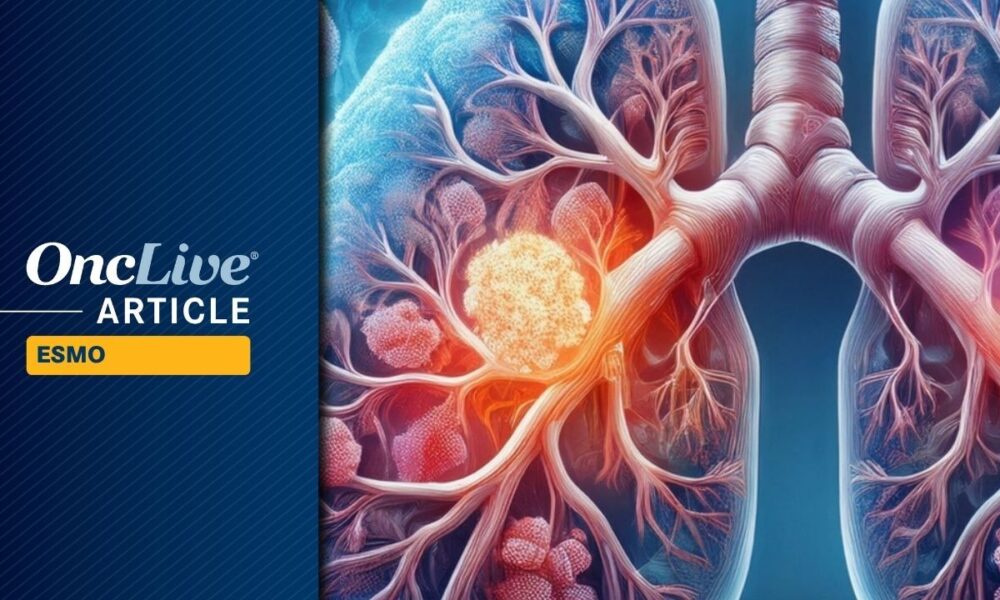A novel treatment regimen combining tarlatamab with first-line chemoimmunotherapy has demonstrated promising efficacy in patients suffering from extensive-stage small cell lung cancer (ES-SCLC). Results from the phase 1b DeLLphi-303 study (NCT05361395) were presented at the 2025 ESMO Congress and published in The Lancet Oncology. The study indicates that this combination therapy yields durable responses alongside a manageable safety profile.
At a median follow-up of 13.8 months, the objective response rate (ORR) stood at an impressive 71%, featuring a complete response rate of 5% and a partial response rate of 66%. Among the participants, 11% experienced stable disease, while 8% encountered progressive disease. The median duration of response (DOR) was recorded at 11.0 months, with a disease control rate of 82%, indicating that the treatment is effective for a significant portion of patients.
Lead study author Martin Wermke, MD, director of the Trial Management/Early Clinical Trial Unit at the German Cancer Research Center in Dresden, emphasized the sustained nature of disease control, noting that 39% of patients maintained control for at least 52 weeks. Furthermore, 49% of patients continued to show responses at the data cutoff, with ongoing data expected to enhance the findings.
The safety profile of the treatment was assessed during a median treatment duration of 46 weeks. Notably, three dose-limiting toxicities were reported, with all patients experiencing treatment-related adverse events (TRAEs). Grade 3 or 4 adverse events were observed in 43% and 35% of participants, respectively. Tragically, one patient died from a TRAE attributed to sepsis linked to the chemotherapy component.
Wermke highlighted that the addition of tarlatamab to chemoimmunotherapy resulted in a safety profile that aligns with the known profiles of the individual agents utilized in the regimen. He stated, “I hope I could convince you that the combination of another frontline chemoimmunotherapy that is PD-L1 targeting in the maintenance setting is safe and has a manageable toxicity profile.”
Current standard treatment for ES-SCLC typically involves a combination of chemoimmunotherapy followed by PD-1/PD-L1 treatment as maintenance therapy. Tarlatamab functions as a bispecific T-cell engager, which has previously been evaluated in the second-line setting as a standalone therapy in the phase 3 DeLLphi-304 trial (NCT05740566).
The 2025 ESMO Congress presentation included data from parts 2, 4, and 7 of the phase 1b DeLLphi-303 study, which assessed tarlatamab in conjunction with frontline chemoimmunotherapy, followed by maintenance therapy with PD-L1 inhibitors in patients with ES-SCLC. This study enrolled adult patients who had received at least one cycle of chemoimmunotherapy, which consisted of platinum-etoposide combined with an anti-PD-L1 inhibitor, regardless of their treatment response.
The study’s design required patients to have measurable disease based on modified RECIST 1.1 criteria, an Eastern Cooperative Oncology Group (ECOG) performance status of 0 or 1, and no active autoimmune diseases. Patients with treated and asymptomatic brain metastases were also included.
During the first three cycles, participants received tarlatamab at 20 mg intravenously (IV) every three weeks, alongside platinum-etoposide and a PD-L1 inhibitor, which was either atezolizumab (Tecentriq) at 1200 mg IV every three weeks or durvalumab (Imfinzi) at 1500 mg IV every three weeks. Following the initial cycles, patients continued with tarlatamab and the PD-L1 inhibitors in the maintenance setting.
The study’s coprimary endpoints included dose-limiting toxicities, treatment-emergent adverse events, and TRAEs, while secondary endpoints encompassed ORR, DOR, disease control, progression-free survival (PFS), and overall survival (OS).
Patient demographics indicated a median age of 63 years across both treatment arms, with 67% of participants being male. The majority of patients were classified as White (74%), followed by Asian (16%), and Other (9%). At diagnosis, 77% presented with extensive-stage disease, and 55% had an ECOG performance status of 1.
Further analysis revealed a median PFS of 10.3 months, with a 12-month PFS rate estimated at 43.1%. The median OS remains not yet estimable, although the 12-month OS rate is projected at 80.6% with the tarlatamab regimen.
Wermke noted that although the trial was not designed to directly compare the two PD-L1 inhibitors, some imbalances were observed in patient characteristics across the treatment groups. He also reported that treatment-emergent cytokine release syndrome (CRS) and immune effector cell-associated neurotoxicity syndrome (ICANS) primarily manifested during the first cycle of tarlatamab, mostly at grades 1 or 2, with all events resolved.
In conclusion, Wermke remarked that these findings support further exploration of this treatment regimen, with future investigations planned in the phase 3 DeLLphi-312 study (NCT07005128).
Disclosures from Wermke revealed honoraria from several pharmaceutical companies, including Amgen and Bristol-Myers Squibb, alongside consulting roles and research funding.







